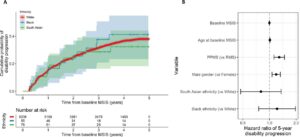
Overview
Fluid biomarkers
- Staging patients using a system of 5 CSF biomarkers – Gemma Salvadó
- Accurate predictions of amyloid status using plasma p-Tau217 – Suzanne Schindler
- A commercially available p-Tau217 assay is effective – Nicholas Ashton
- β-synuclein levels in plasma capture synapse loss in the brain – Patrick Oeckl
- VEGF pathway proteins predict cognitive decline and tau buildup – Wai-Ying Wendy Yau
- Quality control proteins in CSF can stage presymptomatic autosomal AD patients – Haiyan Liu
Presentation Summaries
When it comes to fluid-based biomarkers, those measured in the cerebrospinal fluid (CSF) still have an edge over those in plasma. Gemma Salvadó of Lund University presented her group’s staging system for patients using 5 CSF markers, including a novel one that reflects tau buildup in the brain, that accurately predicts whether patients are positive for amyloid and/or tau according to gold-standard positron-emission tomography (PET). (She and her group have released these findings as a preprint; you can find and discuss it here.) This represents a major step forward in assessing patients, as PET scans are expensive, require highly specialized technology and expertise, and need separate imaging sessions to acquire amyloid and tau information. However, collection of CSF poses challenges for caregivers and patients that must be considered if use of these biomarkers is to become widespread.
Tau-based markers
For judging the buildup of amyloid in the brain, plasma biomarkers may already provide a viable alternative to CSF. That was the argument of Suzanne Schindler (Washington University), who presented data on her group’s assay of phospho-tau217 (p-tau217). In two separate cohorts, her assay was comparable to CSF-based assays in determining whether subjects were positive or negative by amyloid-PET. Its high performance stems from two key factors. Rather than a raw measurement of p-tau217, which can vary for non-neurological reasons such as the ability of the kidneys to clear it, her assay measures the fraction of tau that is phosphorylated at residue 217. Her assay also employs mass spectrometry to measure these levels, whereas most others use an immunoassay system. While this does limit the ability of clinicians to perform the assay in-house, Schindler pointed out that most CSF tests have samples shipped to a central lab, so this isn’t a new drawback. In her view, clinical trials requiring CSF data for subjects to be included represents an undue obstacle when plasma tests are this effective, limiting the pool of test subjects for no compelling reason.
As effective as Schindler’s p-tau assay is, it is not currently commercially available. ALZpath, as presented by Nicholas Ashton (University of Gothenburg), is changing that with their p-tau217 assay. Like the mass spec-based assay above, ALZpath is comparable to CSF-based assays in judging whether subjects are amyloid-positive by PET scanning, this time in 3 distinct cohorts. Furthermore, it proved quite successful in determining whether subjects were positive for tau by PET scanning, as well as whether amyloid-positive patients were also tau-positive. At this stage, the main hurdle for ALZpath is that it requires adherence to strict handling procedures for samples; for real-world use, a more forgiving protocol would be ideal. This, however, is a fairly small price to pay for being able to measure a key biomarker with a blood sample.
Novel biomarkers
Tau-based measurements are a natural fit for AD, given that tau pathology is a hallmark of the disease. The widespread impact of AD on the brain, however, means that numerous other proteins are potential candidates for use as biomarkers.
Elevated levels of synaptic proteins in circulating fluids could serve as signs of synapse loss in the brain. Since most synaptic proteins are also expressed in the peripheral nervous system, assays of these proteins have traditionally used CSF to focus on damage in the central nervous system. Patrick Oeckl (Ulm University Hospital) discussed a way to possibly circumvent this issue by measuring levels of β-synuclein in plasma. Since this presynaptic protein is largely limited to the brain, increased levels in plasma can be more readily attributed to AD pathology. Three separate cohorts found β-synuclein increased specifically in AD, and not other neurodegenerative disorders. Plasma β-synuclein levels correlate with other traditional metrics of AD pathology, such as p-Tau181 and amyloid-PET, as well as cognitive assessments.
Given the role for vascular health in AD, Wai-Ying Wendy Yau (Massachusetts General Hospital) focused on proteins related to vascular endothelial growth factor (VEGF), examining how these proteins correlated with baseline amyloid burden and changes over time in cognition, tau buildup in interior temporal cortex, and hippocampal volume. She found that low VEGF-A and high placental growth factor (PlGF) predicted greater cognitive decline and faster accumulation of tau. The impact of VEGF-A on cognition was fully mediated by its effects on tau, whereas tau mediated only about 30% of the effects of PlGF on cognition.
The aggregation of amyloid-β and tau in AD are, in part, due to an inability of neurons to properly clear them. Breakdown of proteins such as these is mediated by the ubiquitin-proteasome system (UPS). Haiyan Liu (Washington University) investigated whether patients with autosomal-dominant AD had differences in CSF levels of UPS components. Not only were these differences present, but certain components began to increase in patients earlier than others; for example, ubiquitin-like protein 4A levels started 19 years before symptom onset, whereas ubiquitin-specific protease 14 only began to rise 9 years prior to symptoms. This suggests that UPS proteins could provide an alternative to the CSF biomarkers used by Salvadó and colleagues as a staging system for carriers of autosomal-dominant AD.
Conclusion
These studies bring the field closer to having convenient, accessible blood tests for AD widely deployed in the clinic. Mounting data from anti-amyloid treatments argue that early detection and treatment are vital to improving outcomes; doing so at scale will be impossible without blood tests such as these.





